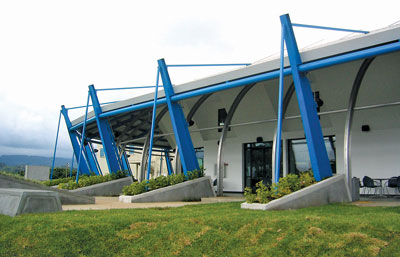

Now, government investment agencies and major outsourcing firms are looking at a potential quick-build solution that has been used by other manufacturing sectors for more than a decade. Sprung Instant Structures, a Calgary-based firm, has been manufacturing stressed membrane structures for a variety of uses, and is now poised to enter the call center market through a partnership with Colliers International’s Toronto-based Call Center Services Group.
Sprung Instant Structures have been widely used by the military, churches, casinos and disaster recovery efforts for many years. Once viewed as temporary structures, they have proved their staying power in many cases and have become permanent. Colliers and Sprung view the technology as having great potential to serve the in-a-hurry call center site location dilemma.
“We had a problem last year when we lost a big multinational investment due to a lack of infrastructure,” says Janine Josephs, knowledge services manager for Jamaica Trade and Invest. “We are evaluating it with local developers and some of our multinational clients that it would help.”
The Jamaican call center sector employs about 10,000, mostly in the Montego Bay area. Josephs wants to take advantage of the call center employee demographics in the heavily populated Kingston suburbs, but there is a shortage of suitable facilities.
“We have human capital that meets all of the demographic requirements of our potential investors,” Josephs says.
Jamaica Trade and Invest has conceptualized a three-pronged approach whereby the Jamaican government provides the land, then a local private developer buys the Sprung structure and leases it back to a call center client.
“This looks like an ideal solution once we work out an agreement with developers,” Josephs says.
Colliers is in talks with at least one major call center and BPO outsourcing firm about using Sprung Instant Structures in locations like the Philippines.
Intel was one of the first major companies to use Sprung Instant Structures. It deployed one for office space when it began ramping up its main campus in Costa Rica in 1997. The facility served the company well for eight years and then was reconfigured as cafeteria space. It continues to be used, says Andres Esquivel, a strategic planner for Intel’s corporate services in Costa Rica.
“It was initially meant to be a temporary building, but it wound up being used for eight years,” Esquivel says. “We are happy with it.”
Esquivel says Sprung buildings are widely used at Intel sites in the U.S., and the company is considering using one for an employee gym in Costa Rica.
“There is a lot of interest in them for call centers,” says Jim Avery, a Sprung vice president. “They have been used for a multitude of applications. Customers like the flexibility of our structures.”
Avery says in addition to speed and reduced construction costs, Sprung Instant Structures offer considerable energy savings, which he calls the product’s “wow factor.” He says Sprung has developed schematics for 20,000 sq. ft. (1,858 sq. m.), 40,000 sq. ft. (3,716 sq. m.), and 80,000 sq. ft. (7,432 sq. m.).
Although the Sprung buildings are now viewed as permanent structures, they can be moved, Avery says. The building comes as a kit – all that is needed is a concrete pad.
Ralph Birkhoff, global director of Colliers’ Call Center Services Group, says while many countries, including the Philippines and Jamaica, have the telecom infrastructure and available labor, there is a shortage of facilities.
“There are literally no facilities in some areas and nothing that companies can convert. It’s a 12-month scenario for a new build, which is too long. So companies move down their list of sites, and that is frustrating to them. This industry cannot wait a year for a building.”
Birkhoff says a Sprung building can be delivered in a five- to six-month time frame, and costs about 60 percent of what a conventional building costs.
“It’s a business solution more than a real estate solution now, but we think it will become a real estate solution,” he says. “We see it ultimately going as a fully operational turnkey call center, working with modular wall firms and IT groups.”
Site Selection Online – The magazine of Corporate Real Estate Strategy and Area Economic Development.
©2009 Conway Data, Inc. All rights reserved. SiteNet data is from many sources and not warranted to be accurate or current.